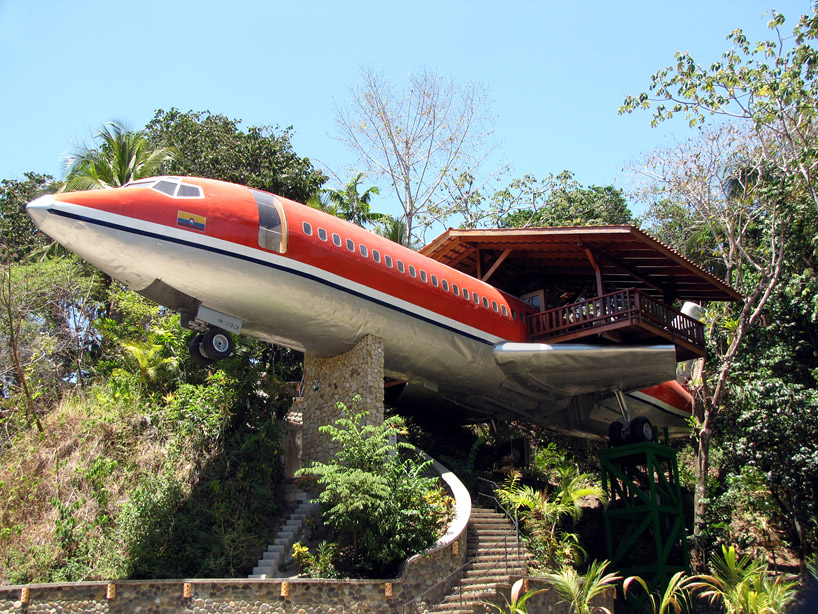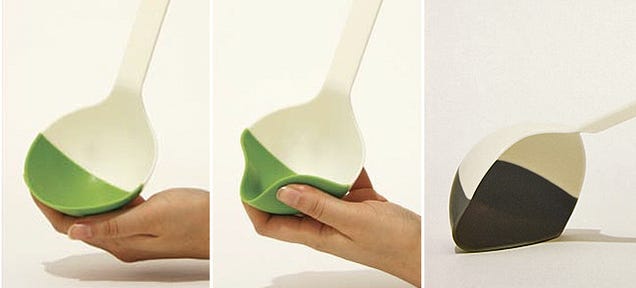boeing 727 hotel suite jets out of the jungle in costa rica
by: Designboom - Weblog, 2014-05-22 11:00:49 UTC

the costa verde hotel offers guests a private stay within a salvaged 1965 refurbished airliner.
The post boeing 727 hotel suite jets out of the jungle in costa rica appeared first on designboom | architecture & design magazine.
NODO Chair: A Metaphor for the Lightness of Being
by: design milk, 2014-05-22 12:00:31 UTC

The lightness of being accepts a certain lack of ultimate meaning in life, while living for the momentary beauty instead. For anyone, whose goal is something higher, they must expect to experience vertigo. Not the fear of falling, but the voice of emptiness inside us, which tempt us over freedom.
To encapsulate this paradox, Pentágono introduced the NODO chair. It’s a handwoven, fiberglass chair that takes the essence of a classic piece of furniture and turns it into a dynamic object. Its fibers are interwoven purposefully to allow the piece to be a conduit of communication between the environment and its context. It debuted at Fuorisalone during Milan Design Week.











 Best of sustainable design at Wanted Design 2014
Best of sustainable design at Wanted Design 2014
by: TreeHugger Design, 2014-05-21 19:20:59 UTC

Part of New York City’s design week, the Wanted Design show offers some of the freshest ideas of 2014.
Aircraft wings that change their shape in flight can help to protect the environment
by: Fraunhofer Research News, 2014-05-19 08:30:00 UTC
A top priority for any airline is to conserve as much fuel as possible – and this helps to protect the environment. The EU project SARISTU aims to reduce kerosene consumption by six percent, and integrating flexible landing devices into aircraft wings is one step towards that target. Researchers will be showcasing this concept alongside other prototypes at the ILA Berlin Air Show from May 20-25 (Hall 6, Booth 6212).
Cold Pot is a Natural Air-Conditioner
by: Jetson Green, 2014-05-11 21:06:38 UTC

Clay has been used to cool things in a natural way for a long time, and recently the Swiss designer Thibault Faverie has created a simple, natural air conditioner from this material. His creation is called Cold Pot, and it utilizes clay and natural evaporation to lower temperatures in a very energy efficient and sustainable way. The unit is also very aesthetic, and looks much like a plant pot.
The Cold Pot is basically a terracotta pot with a porous surface that acts as a heat exchange, with an aluminum pipe to transfer the air and a fan to move the air through the air conditioner. The Cold Pot works by absorbing water from the inside and sending it to the outer surface. Once it comes into contact with the air, this water evaporates, and it is this change from a liquid to a gaseous state that cools the inner aluminum pipe, where air circulates inside the pot.

Apart from the natural evaporative cooling function, the interior pipe of the Cold Pot also contains aluminum “cooling slices,” which are fanned by an electric blower. There is a wide mouth in the bottom of the pot through which the air passes and where it is cooled. According to Faverie, this natural air conditioner requires very little maintenance, since it uses only two liters (approximately half a gallon) of water to lower the temperature of the air to 8 to 10 degrees Celsius (14.5 to 18 Fahrenheit). The Cold Pot is of course powered by electricity, but it uses a lot less power than your regular AC unit.


Due to its relatively small size, the Cold Pot can’t really be used to cool very large spaces. Though it could conceivably work very well to cool a tiny home, while there’s always the option of using more of them to cool a room. Either way, the idea is very green and sustainable, and a great example of using traditional knowledge in modern designs. More information about the Cold Pot can be obtained from Thibault Faverie’s website.
 A Semi-Soft Silicone Ladle Would Scoop Out Every Last Drop
A Semi-Soft Silicone Ladle Would Scoop Out Every Last Drop
by: Gizmodo , 2014-05-18 14:00:00 UTC

Trying to get every last drop of liquid out of a serving bowl with a ladel is all but impossible. The contours of the rigid scoop and the bowl never seem to match up. But designer Jeho Yoon had a brilliant solution. Since a ladel made entirely from silicone would have no rigidity, he compromised by only making half the scoop from the flexible material, allowing it could squeeze into contoured corners.
Read more...






 Scrap ‘Best Before’ Labels on Long-Life Foods, EU States Say
Scrap ‘Best Before’ Labels on Long-Life Foods, EU States Say
by: Environmental Leader, 2014-05-16 15:12:07 UTC
“Best before” labels add to food waste, according to several European Union states that are asking the European Commission to exempt products — such as some long-life produce — from the mandatory labels. According to a discussion paper, put forward by the Netherlands and Sweden and backed by Austria, Denmark, Germany and Luxembourg, many food […]
 Talk About Range Anxiety: This All-Electric Plane Flies An Hour Per Charge
Talk About Range Anxiety: This All-Electric Plane Flies An Hour Per Charge
by: Co.Exist, 2014-05-09 13:08:00 UTC
The tiny new E-Fan, an all-electric plane from Airbus, won't be flying cross-country anytime soon, but it's a major leap forward.
If you live in the U.S., the biggest part of your carbon footprint probably comes from air travel--a single round-trip flight from New York to San Francisco can add up to about two or three tons of carbon emissions per passenger. But airlines are slowly inching their way closer to truly green options.
Read Full Story






 Sustainable and Affordable Housing Built in Santa Monica
Sustainable and Affordable Housing Built in Santa Monica
by: Jetson Green, 2014-05-04 21:41:28 UTC

The firm Kevin Daly Architects successfully renovated an old, vacant nursing home on the Westside of Los Angeles, turning it into sustainable and affordable housing units. The aim of the Broadway Housing project, as it is called, was to provide low-income families with a place to live that is within their limited budget, yet still environmentally and economically sustainable.
Broadway Housing is a three-story, four building complex that consists of 33 units. It is located on a 1.5-acre site, of which it intelligently utilizes every inch of available surface. The housing complex has access to a big community park, as well as a diverse range of transportation options such as the future Bergamont Station Expo line and newly established bike lanes.
The four buildings of the complex are arranged around an internal courtyard that consists of a play area and two fully wired community rooms, where meetings and classes can be held. This internal courtyard offers a safe environment for children to play in, as well as for other residents to garden, and even grow their own food.

One of the main sustainable features of the housing complex is its green roof, which insulates the complex and slows runoff. The housing units were also fitted with custom window frames that minimize solar heat gain, as well as canted wall panels that breathe and release heat. The housing units have also been fitted with a vegetative screen wall that insulates and reflects noise. For irrigation of the landscape, a 15,000 gallon rainwater collection cistern was installed underground.
None of the apartments have an AC unit, since the temperatures stay comfortable due to the smart, integrated sustainable design of the complex. As for water efficiency, there are flow restrictors in the kitchens and bathrooms. The interior was also fitted with a 100% recycled CRI Green-label carpet, formaldehyde-free insulation, and low-VOC paint.


The apartments in the complex vary in sizes. The larger three-bedroom units are located at the ground level, while smaller, two-bedroom units are located on the upper levels. The latter are connected via latticed bridges that envelope a central, shared courtyard. All of the 33 units also face the central courtyard and the designers made sure that each of the units gets plenty of natural light and has maximum ventilation.


 A Plug That Can Reduce Your Energy Bill by Half
A Plug That Can Reduce Your Energy Bill by Half
by: Jetson Green, 2014-05-08 22:34:05 UTC

The Parce One smart plug works by measuring and controlling the energy usage of your electronic devices. The plug is Wi-Fi enabled, so it also gives users access to detailed reports and even suggestions on how to reduce energy use. The makers of the Parce One smart plug have recently run a successful IndieGoGo campaign and the funds they raised will go towards the further development of the plug with a view towards mass production in the near future.
The Parce One smart plug is not just a monitoring device, though. It is also capable of learning the users’ daily habits and recording how and when energy is being used. The smart plug can be set to fully automatic, meaning the user can enable it to turn off lights, electronics and appliances to conserve energy automatically. Monitoring is possible via a smartphone app, or a dedicated website, both of which give the user the ability to remotely turn off their appliances, if they need to do so.


According to the manufacturers, the Parce One smart plug could potentially save you up to $200 a year in energy costs, which is about 30-50% of an annual bill. This savings could be even bigger if the smart plug is used in offices or factories.
Since the plug is still being developed, the exact cost of it is as yet unknown, but according to the makers, users will be able to recoup their investment in 6 to 24 months of use (depending on the device the smart plug is used with. But the reduction in energy costs is not all that users will get from using this plug. An average household will also contribute to a “savings” of about half a ton of CO2 per year per household when using the Parce One smart plug.
The Parce One smart plug looks like a great idea on paper, and has the potential to become an all-in-one intelligent energy saving device. For more information, check out the Parce One smart plug IndieGoGo campaign page.


Comments by our Users
Be the first to write a comment for this item.